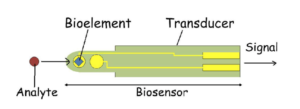Biosensor Definition
Although the term “biosensor” may seem quite clear on first glance, its meaning is less straightforward. A linguist might say a biosensor is a device that “senses life”, as its etymology would suggest. A biologist on the other hand would argue that the term “life” is too broad, while a physicist would likely be confused by the meaning of “sensing”. The question then is: What is a biosensor?
A Definition for All
One of many official definitions states that a biosensor is “a device that uses specific biochemical reactions mediated by isolated enzymes, immunosystems, tissues, organelles or whole cells to detect chemical compounds” (IUPAC definition). Put simply, this means that a biosensor utilizes molecular interactions from or based on those in living systems to detect a compound of interest.
There is a myriad of ways to accomplish this, which is why finding a definition that suits all possible biosensors is a challenging task. There are however three basic elements all biosensors have:
- a bioreceptor: any biological compound capable of detecting the compound of interest (aka “analyte”, cf. figure). Typical examples include biomolecules such as enzymes, antibodies, but also living organisms such as cells.
- a signal processor: the part of the biosensor that will convert the physicochemical signal from the receptor to a quantifiable signal we can interpret.
- a transducer: the part of the biosensor that will link the bioreceptor detecting the compound to the signal processor.

Label vs. Label-Free Biosensors
Biosensors can be classified according to various parameters, such as what type of bioreceptor they use, what transduction type, or what signal processing mechanism they use. Although these classifications can be very useful, they don’t always provide the most practical information. One broader way to categorize biosensors is by separating them into two big classes.
Label biosensors detect the presence and/or activity of molecules of interest thanks to a special tag, the label, that is attached to them. A typical example of such a sensing technology is ELISA (enzyme-linked immunosorbent assay). On the other hand, label-free biosensors detect the presence and/or activity of molecules of interest based on their biophysical properties, such as molecular weight, refractive index (e.g. surface plasmon resonance) or charge. Other examples of label-free technologies include the microcantilever, quartz crystal microbalance and mass spectroscopy.
What is a label?
Think of a label as a type of tag for molecules. When you go shopping, each clothing item has a tag with a barcode; this is necessary because a store usually has several copies of the same item. Tags with barcodes allow differentiation of identical items amongst each other, which thereby allows stores to keep track of the number of items they have and the location of each item. Labels in biosensors have a similar function: they help us follow or detect a molecule of interest, so we can distinguish it from the others. In biosensors, the most common way to label a molecule is by attaching a color tag, most often in the form of fluorescent molecules.
Beyond simple molecule distinction, labels also enable molecule detection in a simple, visible manner. Indeed, labels provide signal amplification. If the label is attached to an enzyme specific for a molecule of interest, this enzyme can create multiple copies of the color tag every time it binds its specific target molecule. In short, this means one specific binding event will lead to multiple copies of the color tag molecule, which makes it much easier to detect the analyte of interest.
Which is better?
Using a label is a seemingly smart and practical way to keep track of and detect the molecules we are interested in; however, in biosensing, this isn’t necessarily the case. Indeed, adding labels can cause problems in accurate and precise detection. Firstly, the labels we use are molecules themselves, and these tend to be quite chunky molecules. This means that by attaching them to the molecules we are interested in, we create a much larger and different molecule: this alters the intrinsic properties of the molecule of interest, thereby affecting its transport, activity, and sometimes also its effect. In short, by adding a label, we may not be measuring what we want to measure… Furthermore, adding labels always involves an additional and non-straightforward step in the preparation/fabrication of the biosensor and requires isolation and purification of the molecules of interest.
This is why label-free technologies are often the preferred strategy for biosensing where one is interested in the thermodynamic properties rather than the identity of the molecule or the concentration of the molecule.
What concrete examples of label and label-free biosensors are there? How do these biosensors work, and what are their functions? Stay tuned and read more about these questions in the next blog article.

